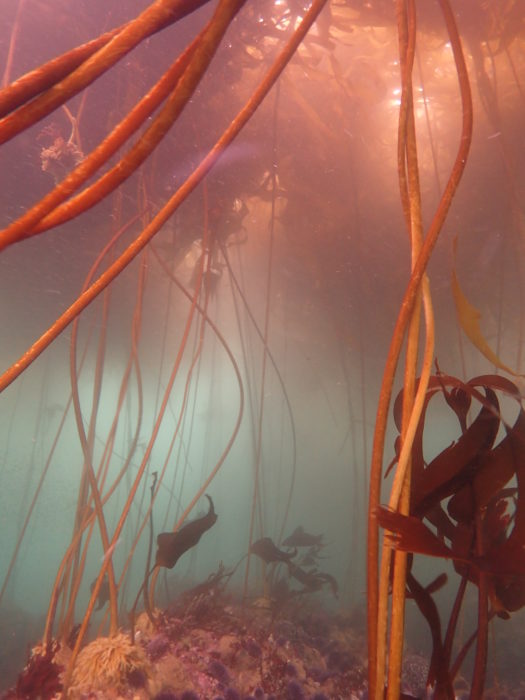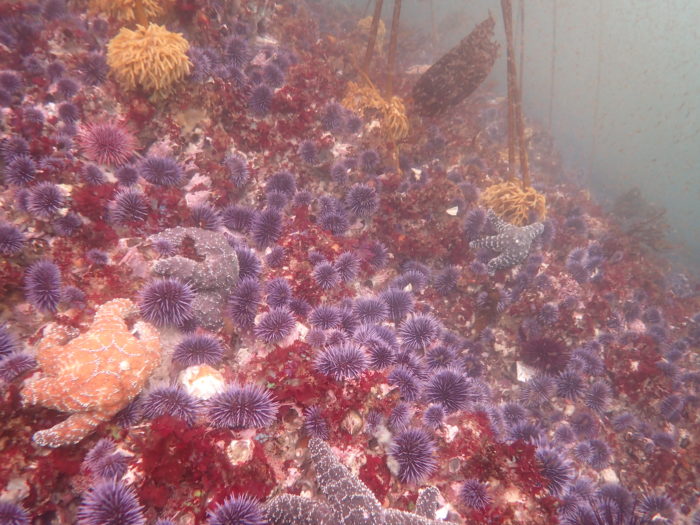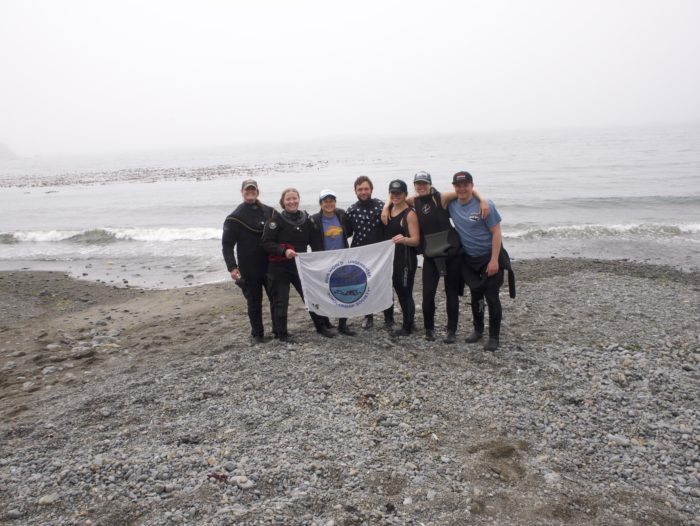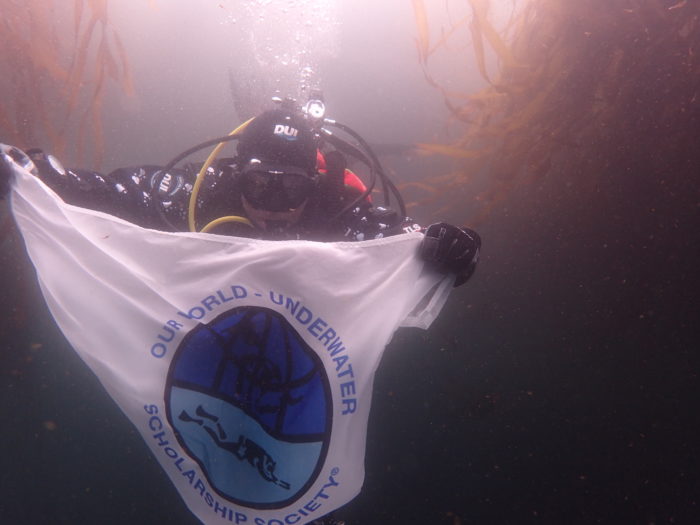One of my greatest endeavor this year was to submerge myself within the canopy layers of a kelp forest. Kelp, for the longest time, was the spinach of the sea to me, and I had zero interest in getting near it. But little did I know back in the day that kelp is one of the major groups of sea plants; one that in fact forms spectacular underwater forests. Feeding my imagination based on mere rumors was not satisfying to me, so I set off to the coasts of Northern California to seek my own fantastic kelp experience.

I arrived at Monterey Bay, where I met up with Dr. Kerry Nickols, a former North American Rolex Scholar (2003) and researcher of Californian kelp. Kerry’s lab aims to answer questions pertaining to the effects of climate change on kelp forests, and her team was just wrapping up their field season for the year. Nevertheless, I joined Kerry on a fun shore dive to scout for new working sites. Our entries into the water were far from graceful, as we tumbled over the seagrass into the surge and amused the harbor seals hovering around us with their heads fixed but their bodies contorting along the movement of the tides.
We finally made it further in and descended into the cool, emerald-green waters of the bay. Visibility was splendid – at a first glance we saw great big boulders covered with nudibranchs, anemones, some crabs and these beautiful purple urchins. We continued swimming and we saw some more urchins, and then a couple more, and then a bit more. Until suddenly it hit me that we were seeing nothing but urchins. Where was the kelp? Where were these long and leafy strings anchoring the seafloor and surface together? We had entered into what locals are calling an urchin barren – a land of eternal spines – one of the major threats facing the kelp forests of Northern California.

The populations of purple urchins have boosted over the past couple of years, outcompeting other species and growing exponentially without the presence of any consistent predators anymore. These little guys are voracious; in fact they are so hungry that they are grazing everything in their way and even resort to cannibalism. They have consumed a staggering amount of the kelp that used to thrive in these waters.
Much debate has been made over how to solve this issue and whether humans can play a role in lowering the urchin population to recover the lost kelp. Do we remove them? Do we fish them? Solving this issue is an intricate challenge. One that a research team from UC Davis and California Fish and Game, led by ‘abalone-extroaordinnaires’ Cynthia Catton and Laura Rogers-Bennett, are trying to solve.


I was lucky to volunteer alongside this team in their annual invertebrate survey project, where they aim to evaluate the state of the abalone populations along the coasts of Northern California. Abalone are being severely affected by the purple urchin reign, given that they rely on kelp and other algae, they are now starving and numbers plummeting. Abalone are a strong symbol of the region; they were an extremely important fishery for both commercial and recreational purposes, and now the fishery is closed as a preventative measure from further population decimation. With the anger of the community and ecological pressure behind their back, the team at California Fish and Game engages in an outstanding research effort that gathers people from all over the state in the hopes of understanding this problem a bit better.
As a volunteer diver, I had the opportunity to observe the magnitude of the work this team does and partake in several of their research operations in the Van Damme study site in Fort Bragg. My first task got me smashing purple urchins with a hammer, an experience that I absolutely hated. Spending almost 80 minutes underwater being face to face with these urchins got me reflecting way too deeply on my ethics as a human being and my place sharing this world with other creatures. Fortunately, this didn’t last long as the subsequent assignments were far more enjoyable. We connected a series of artificial abalone habitats and surveyed the growing organisms surrounding them, alongside collecting silty residues from the surfaces to search for potential abalone larvae. We also conducted several transect surveys to estimate the abundance of urchins and abalone as well as map out the seafloor composition.

Until finally I got my taste of kelp forest magic. I set out on a mission with Cynthia Catton to document the state of some kelp forest patches on the outskirts of Van Damme. The day was extra foggy and grey, and conditions were “dynamic,” to say the least. We plunged into the water and descended alongside the canopy. These luscious, earthy stems were towering in front of us, providing a dramatic display of light penetrating through the surface leaves. But at the bottom, surrounding the base of the patch, was an army of urchins, staggering one on top of the other. Cynthia was in her element. She knew the wavy environment well and was one with the surge. I, on the other hand, had fears. I feared that I would slam onto the ground and pop my drysuit on these urchins. I feared that the swell would push me towards the surface so hard that the air inside my BCD would slop me right out of the water. But regardless of how present these fears were, they could not surpass the feeling of awe of the kelp, one that is often mentioned when entering places of contemplation like temples or churches.
We swam around the patch and wandered into the surroundings, observing numerous individuals that we hadn’t encountered before near the urchin barrens. We saw sea stars, anemones, rockfish, octopuses and several other critters. Just observing how evident the sacred space that the kelp forest offers to all these species was astonishing. They find a home in these forests. Suddenly it became clear that to me that we, as humans, have a much larger role to play than just intervening and trying to control the changes in our environment. We have the capacity to study these changes and facilitate the adaptation of these species into an evolving world.
(Here is a corny video I made upon reflection)
I noticed my air was running low. I had been kicking so hard fighting against the surge that I was sucking oxygen like a vacuum. No more time for contemplation and reflection, so Cynthia and I made our way back into the kelp patch and started our ascent to our safety stop, and then up into the surface. When we got out, the boat captain came to pick us up and asked if we had seen the grey whale. Cynthia and I both threw that question behind our back, thinking the chances of seeing a whale inside a kelp forest were beyond reason. But suddenly we heard a loud blow and we looked behind. There was a whale indeed, swimming amongst the kelp. I immediately sunk my head and tried to look ahead but couldn’t see anything. I stuck my head out of the surface again but saw no sign of the blow. One last mask dip in the water and I spotted a grey blob underneath. My heart started pumping, so I instantly lifted my head, turned around and told Cynthia the whale was right below. I turned around and dunked my head. The whale was not underneath, it was coming to the surface, in fact, it was coming at me. We exchanged gazes and I sensed the whale’s discomfort as it abruptly steered away from this paw-printed, bright orange entity floating in front of it. I smelled its breath, watched its entire mouth and baleen teeth slurp some water and could even feel the barnacles on its grey skin. The tail dunked and it headed to the depths, leaving a path of turbulence with me spinning in it.
Did I just imagine all of that? Was I narced? I pulled myself together and headed towards Cynthia and the captain. When I saw their faces I knew this had been for real.
Contemplation and awe can strike you immediately, regardless of how much air you have left, because some experiences are just breathless.

Big thanks to